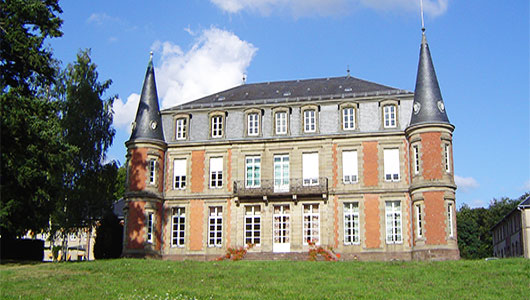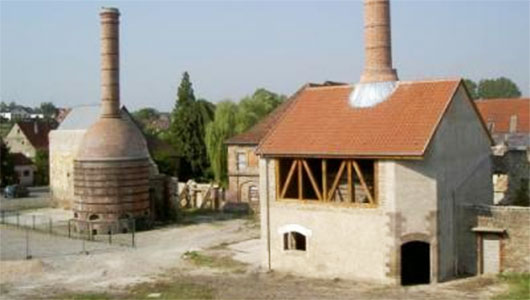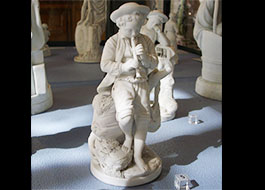Niderviller
Durée visite : 60 min
Moyen : Pédestre
L’origine du nom de la commune vient de l’adjectif germanique nieder « d’en bas » + weiler « le village » le village d’en bas. Niderviller faisait à l’origine partie du duché de Lorraine. Il fut cédé à la France en 1661 avec les autres localités de la prévôté de Sarrebourg. Il y avait autrefois un château seigneurial qui appartenait au général de Custine. Ce dernier est né le 4 février 1742 à Metz et guillotiné le 28 août 1793 à Paris. Député de la noblesse de Metz aux États généraux de 1789, il vote souvent avec la noblesse libérale de La Fayette, et fait partie des premiers à se rallier au Tiers-état. A-P Custine acquiert la seigneurie de Niderviller en 1770, avec la faïencerie. Il y poursuit l’œuvre de son prédécesseur, Jean-Louis Beyerlé jusqu’à sa mort.
The origin of the name of the town comes from the Germanic adjective nieder “from below” + weiler “the village” the village from below. Niderviller was originally part of the Duchy of Lorraine. It was ceded to France in 1661 with the other localities of the provost of Sarrebourg. There was once a stately castle that belonged to General de Custine. The latter was born on February 4, 1742 in Metz and guillotined on August 28, 1793 in Paris. Deputy of the nobility of Metz in the Estates General of 1789, he often votes with the liberal nobility of La Fayette, and is one of the first to join the Third Estate. A-P Custine acquired the seigneury of Niderviller in 1770, with the earthenware factory. There he continued the work of his predecessor, Jean-Louis Beyerlé until his death.
Der Ursprung des Stadtnamens stammt aus dem germanischen Adjektiv nieder « von unten » + weiler « das Dorf » das Dorf von unten. Niderviller war ursprünglich Teil des Herzogtums Lothringen. Es wurde 1661 mit den anderen Orten des Provost von Sarrebourg an Frankreich abgetreten. Es gab einmal eine stattliche Burg, die General de Custine gehörte. Letzterer wurde am 4. Februar 1742 in Metz geboren und am 28. August 1793 in Paris guillotiniert. Als Stellvertreter des Adels von Metz in den Generalständen von 1789 stimmt er häufig mit dem liberalen Adel von La Fayette ab und ist einer der ersten, der sich dem Dritten Stand anschließt. A-P Custine erwarb 1770 mit der Steingutfabrik das Seigneury von Niderviller. Dort setzte er die Arbeit seines Vorgängers Jean-Louis Beyerlé bis zu seinem Tod fort.

Écartelé: aux 1er et 4e d’argent à la bande de sable côtoyée de deux cotices du même, aux 2e et 3e de sable semé de fleurs de lis d’argent; à la croix de Lorraine de gueules accostée des lettres capitales N et V du même brochant sur le tout.
Ce sont les armes de la famille de Custines, qui possédait la seigneurie au XVIIIe siècle et a fondé la faïencerie. La croix de Lorraine accostée des lettes N et V constituent la marque de cette célèbre faïencerie. (UCGL)
Quarterly: 1st and 4th Argent, a strip of sand bordered by two cotices of the same, 2nd and 3rd Sable sown with fleur-de-lis Argent; to the cross of Lorraine Gules accosted of the capital letters N and V of the same debris on the whole.
These are the arms of the Custines family, who owned the seigneury in the 18th century and founded the earthenware factory. The cross of Lorraine accosted by letters N and V constitute the mark of this famous pottery. (UCGL)
Vierteljährlich: 1. und 4. Argent, ein Sandstreifen, der von zwei Cotices desselben begrenzt wird, 2. und 3. Sable, gesät mit Lilie Argent; zum Kreuz von Lothringen Gules, das die Großbuchstaben N und V derselben Trümmer insgesamt ansprach.
Dies sind die Waffen der Familie Custines, die im 18. Jahrhundert das Seigneury besaß und die Steingutfabrik gründete. Das Lothringerkreuz mit den Buchstaben N und V ist das Kennzeichen dieser berühmten Keramik. (UCGL)

Die Tellerschlecker = les lécheurs d’assiettes.
Ce terme, qui se traduit habituellement, au figuré, par pique – assiettes (parasite qui court les dîners) et aussi par gourmand ou gourmet, ne semble pas être applicable comme tel aux anciennes générations de ce village. Il s’agit plutôt d’un appellatif, attribué aux habitants de Niderviller, parce qu’ils se servaient de bonne heure d’assiettes, achetées sur place à la Manufacture de porcelaine et de faïence, fondée par le général de Custine, tandis qu’ailleurs dans la région, on se contentait encore de tranchoirs et d’écuelles. Disons aussi que trois autres localités en Moselle portent le même sobriquet Fénétrange, Racrange et Wittring.
Réf. Dusanus, Volkshumor
Renseignement de M. N. K.
Die Tellerschlecker = the plate lickers.
This term, which is usually translated, figuratively, by picnic (parasite that runs dinners) and also by gourmand or gourmet, does not seem to be applicable as such to the older generations of this village. It is rather an appellation, attributed to the inhabitants of Niderviller, because they used early plates, bought on the spot at the Manufacture de porcelaine et de faience, founded by General de Custine, while ‘elsewhere in the region, people were still content with slicers and bowls. Let’s also say that three other localities in Moselle bear the same moniker Fénétrange, Racrange and Wittring.
Ref. Dusanus, Volkshumor – Information from Mr. N. K.
Die Tellerschlecker = Tellerlecker.
Dieser Begriff, der normalerweise im übertragenen Sinne durch Pik (Parasit, der Abendessen führt) und auch durch Feinschmecker oder Feinschmecker übersetzt wird, scheint als solcher für die älteren Generationen dieses Dorfes nicht anwendbar zu sein. Es ist eher eine Bezeichnung, die den Einwohnern von Niderviller zugeschrieben wird, weil sie frühe Teller verwendeten, die vor Ort bei der von General de Custine gegründeten Manufaktur für Porzellan und Steingut gekauft wurden „Anderswo in der Region waren die Menschen immer noch mit Schneidemaschinen und Schüsseln zufrieden. Nehmen wir auch an, drei andere Orte in der Mosel tragen den gleichen Spitznamen Fénétrange, Racrange und Wittring.
Ref. Dusanus, Volkshumor – Informationen von Herrn N. K.

Les habitants et les habitantes de Niderviller s’appellent les Nidervillois et les Nidervilloises.
The inhabitants of Niderviller are called Nidervillois and Nidervilloises.
Die Einwohner von Niderviller heißen Nidervillois und Nidervilloises.
Les points de visites
.
La faïencerie de Niderviller, l’une des plus anciennes de Lorraine, est aussi la deuxième manufacture en France à avoir fabriqué également de la porcelaine. Elle fut créée à Niderviller en 1735. Tirant le meilleur parti de sa situation géographique, proche de l’Allemagne et de ses savoir-faire techniques (qu’on pense en particulier à Meissen) et influencée par les mouvements artistiques français (notamment Antoine Watteau), la finesse de ses productions la font souvent comparer à la Manufacture de Sèvres. La faïencerie est aujourd’hui une filiale du groupe Les Jolies Céramiques sans kaolin. Les céramiques de Niderviller sont exposées dans de nombreux musées à travers le monde: Musée d’anthropologie de Vancouver British Columbia, au Canada, mais aussi le Smithsonian Institution à Washington (district de Columbia), le Metropolitan Museum of Art à New York où sont exposées les statues des 4 continents.
The Niderviller earthenware factory, one of the oldest in Lorraine, is also the second factory in France to have also made porcelain. It was created in Niderviller in 1735. Making the most of its geographical location, close to Germany and its technical know-how (which we think in particular of Meissen) and influenced by French artistic movements (notably Antoine Watteau ), the finesse of its productions often make it compared to the Manufacture de Sèvres. The earthenware factory is today a subsidiary of the Les Jolies Céramiques group without kaolin. Niderviller’s ceramics are exhibited in many museums around the world: Museum of Anthropology in Vancouver British Columbia, Canada, but also the Smithsonian Institution in Washington (District of Columbia), the Metropolitan Museum of Art in New York where are exhibited statues from 4 continents.
Die Steingutfabrik Niderviller, eine der ältesten in Lothringen, ist auch die zweite Fabrik in Frankreich, in der ebenfalls Porzellan hergestellt wurde. Es wurde 1735 in Niderviller gegründet. Das Beste aus seiner geografischen Lage in der Nähe Deutschlands und seinem technischen Know-how (das wir insbesondere an Meißen denken) und dem Einfluss französischer künstlerischer Bewegungen (insbesondere Antoine Watteau) ), die Finesse seiner Produktionen machen es oft im Vergleich zur Manufacture de Sèvres. Die Steingutfabrik ist heute eine Tochtergesellschaft der Gruppe Les Jolies Céramiques ohne Kaolin. Nidervilleers Keramik wird in vielen Museen auf der ganzen Welt ausgestellt: im Museum of Anthropology in Vancouver, British Columbia, Kanada, aber auch in der Smithsonian Institution in Washington (District of Columbia) und im Metropolitan Museum of Art in New York ausgestellte Statuen aus 4 Kontinenten.
.
.
Le 22 août 1807, Jean Pons VIDIL achète à la succession Custine deux forêts, dont l’une de 156 ha, appelée La Forêt de la Carrière. Un demi-siècle plus tard un Parisien du nom de Léopold HALPHEN, acquiert ce domaine et fait construire entre 1860 et 1863, un château dans une clairière de la forêt de Niderviller. C’est le Château des carrières! Sa fille unique épouse le propriétaire de la ferme d’Oberviller. En 1888, le Baron Von Stietencron, capitaine de la garde prussienne, achète l’ensemble du domaine. Personnage ombrageux, il tue, le 12 juillet 1901 un ouvrier italien qui avait traversé sa propriété, pour aller travailler à la conduite d’eau en construction. Il est acquitté par le conseil de guerre comme ayant agi en cas de légitime défense. Le tribunal civil de Saverne le condamne toutefois à verser une rente à la famille de la victime, mais la Cour d’appel de Colmar annule ce jugement.
On August 22, 1807, Jean Pons VIDIL bought two forests from the Custine estate, including one of 156 ha, called La Forêt de la Carrière. Half a century later a Parisian by the name of Léopold HALPHEN, acquired this estate and had a castle built between 1860 and 1863 in a clearing in the forest of Niderviller. This is the Château des Carrières! His only daughter marries the owner of the Oberviller farm. In 1888, Baron Von Stietencron, captain of the Prussian Guard, bought the entire estate. A skittish figure, on July 12, 1901, he killed an Italian worker who had crossed his property to go and work on the water pipe under construction. He was acquitted by the council of war as having acted in self-defense. The civil court of Saverne however condemns him to pay an annuity to the family of the victim, but the Court of Appeal of Colmar annuls this judgment.
Am 22. August 1807 kaufte Jean Pons VIDIL zwei Wälder vom Custine-Anwesen, darunter einen von 156 ha, La Forêt de la Carrière. Ein halbes Jahrhundert später erwarb ein Pariser namens Léopold HALPHEN dieses Anwesen und ließ zwischen 1860 und 1863 auf einer Lichtung im Wald von Niderviller eine Burg errichten. Dies ist das Château des Carrières! Seine einzige Tochter heiratet den Besitzer des Oberviller Hofes. 1888 kaufte Baron Von Stietencron, Kapitän der preußischen Garde, das gesamte Anwesen. Als scheußlicher Charakter tötete er am 12. Juli 1901 einen italienischen Arbeiter, der sein Grundstück überquert hatte, um an der im Bau befindlichen Wasserleitung zu arbeiten. Er wurde vom Kriegsrat als Selbstverteidiger freigesprochen. Das Zivilgericht von Saverne verurteilt ihn jedoch, der Familie des Opfers eine Rente zu zahlen, aber das Berufungsgericht von Colmar hebt dieses Urteil auf.











